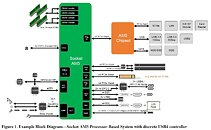- Joined
- Oct 9, 2007
- Messages
- 47,878 (7.38/day)
- Location
- Dublin, Ireland
| System Name | RBMK-1000 |
|---|---|
| Processor | AMD Ryzen 7 5700G |
| Motherboard | Gigabyte B550 AORUS Elite V2 |
| Cooling | DeepCool Gammax L240 V2 |
| Memory | 2x 16GB DDR4-3200 |
| Video Card(s) | Galax RTX 4070 Ti EX |
| Storage | Samsung 990 1TB |
| Display(s) | BenQ 1440p 60 Hz 27-inch |
| Case | Corsair Carbide 100R |
| Audio Device(s) | ASUS SupremeFX S1220A |
| Power Supply | Cooler Master MWE Gold 650W |
| Mouse | ASUS ROG Strix Impact |
| Keyboard | Gamdias Hermes E2 |
| Software | Windows 11 Pro |
AMD might fall behind Intel on PCI-Express Gen 5 support, say sources familiar with the recent GIGABYTE ransomware attack and ensuing leak of confidential documents. If you recall, AMD had extensively marketed the fact that it was first-to-market with PCI-Express Gen 4, over a year ahead of Intel's "Rocket Lake" processor. The platform block-diagram for Socket AM5 states that the AM5 SoC puts out a total of 28 PCI-Express Gen 4 lanes. 16 of these are allocated toward PCI-Express discrete graphics, 4 toward a CPU-attached M.2 NVMe slot, another 4 lanes toward a discrete USB4 controller, and the remaining 4 lanes as chipset-bus.
Socket AM5 SoCs appear to have an additional 4 lanes to spare than the outgoing "Matisse" and "Vermeer" SoCs, which on higher-end platforms are used up by the USB4 controller, but can be left unused for the purpose, and instead wired to an additional M.2 NVMe slot on lower-end motherboards. Thankfully, memory is one area where AMD will maintain parity with Intel, as Socket AM5 is being designed for dual-channel DDR5. The other SoC-integrated I/O, as well as I/O from the chipset, appear to be identical to "Vermeer," with minor exceptions such as support for 20 Gbps USB 3.2x2. The Socket has preparation for display I/O for APUs from the generation. Intel's upcoming "Alder Lake-S" processor implements PCI-Express Gen 5, but only for the 16-lane PEG port. The CPU-attached NVMe slot, as well as downstream PCIe connectivity, are limited to PCIe Gen 4.

View at TechPowerUp Main Site
Socket AM5 SoCs appear to have an additional 4 lanes to spare than the outgoing "Matisse" and "Vermeer" SoCs, which on higher-end platforms are used up by the USB4 controller, but can be left unused for the purpose, and instead wired to an additional M.2 NVMe slot on lower-end motherboards. Thankfully, memory is one area where AMD will maintain parity with Intel, as Socket AM5 is being designed for dual-channel DDR5. The other SoC-integrated I/O, as well as I/O from the chipset, appear to be identical to "Vermeer," with minor exceptions such as support for 20 Gbps USB 3.2x2. The Socket has preparation for display I/O for APUs from the generation. Intel's upcoming "Alder Lake-S" processor implements PCI-Express Gen 5, but only for the 16-lane PEG port. The CPU-attached NVMe slot, as well as downstream PCIe connectivity, are limited to PCIe Gen 4.

View at TechPowerUp Main Site






 (no need to answer i know it, but is it needed?) still the difference in price between a S11 and a S70 is a "mere" 30chf ... why not, in the end.
(no need to answer i know it, but is it needed?) still the difference in price between a S11 and a S70 is a "mere" 30chf ... why not, in the end.






